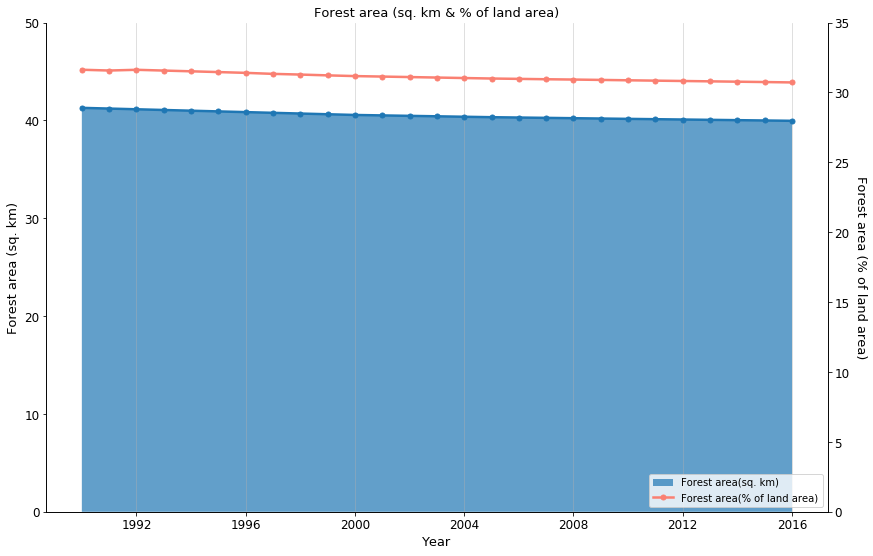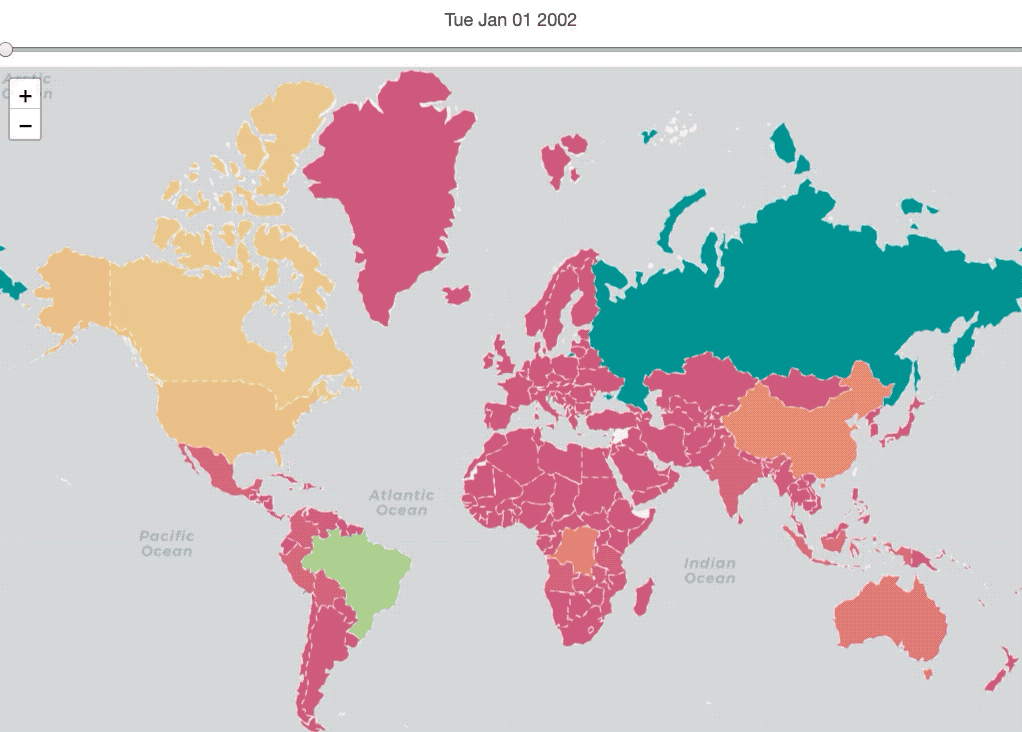Forests are the dominant terrestrial ecosystem of Earth, and are distributed around the globe. Forests account for 75% of the gross primary production of the Earth’s biosphere, and contain 80% of the Earth’s plant biomass. Net primary production is estimated at 21.9 gigatonnes carbon per year for tropical forests, 8.1 for temperate forests, and 2.6 for boreal forests. In this blog, I will talk about forest area with the following points:
- Forest area evolution all over the world
- Forest area evolution for different continents
Forest area evolution all over the world

Forests cover some 3.9 billion hectares (or 9.6 billion acres) which is approximately 30% of the world’s land surface. According to the graph above, we find that from 1990 to 2016, the world’s forest area decreases 3% (41282694.9 - 39958245.9 = 1324449 sq. km). In the next part, we will go deeper in terms of continent.
Forest area evolution for different continents

According to the graph above, obviously, Russia’s forest is larger than other countries in the world. The top 5 countries in terms of forest area are Russia, Brezil, Canada, United States and China; especially for China, its forest area increases 14.4% (264456 square km) from 2002 to 2016. In the following, I’ll introduce forest’s distribution over the world.
Africa’s forest cover is estimated at 650 million hectares or 17 percent of the world’s forests. The major forest types are dry tropical forests in the Sahel, Eastern and Southern Africa, moist tropical forests in Western and Central Africa, subtropical forest and woodlands in Northern Africa, and mangroves in coastal zones of the southern tip.
Asia and the Pacific region accounts for 18.8 percent of global forests. Northwest Pacific and East Asia has the largest forest area followed by Southeast Asia, Australia and New Zealand, South Asia, South Pacific and Central Asia.
Europe’s 1 million hectares of forests comprise 27 percent of the world’s total forested area and cover 45 percent of the European landscape. A wide variety of boreal, temperate and subtropical forest types are represented, as well as tundra and montane formations.
Forests cover about 26 percent of North America’s land area and represent more than 12 percent of the world’s forests. The United States is the fourth most forested country in the world with 226 million hectares. Canada’s forest area has not grown during the past decade but forests in the United States have increased by almost 3.9 million hectares. Forests and woodlands of West Asia occupy only 3.66 million hectares or 1 percent of the region’s land area and account for less than 0.1 percent of the world’s total forested area.
Latin America and the Caribbean are some of the world’s most important forest regions, with nearly one-quarter of the world’s forest cover. The region contains 834 million hectares of tropical forest and 130 million hectares of other forests.
However, the Amazon rainforest has been on fire for the past month, it’s home to at least 10% of the world’s biodiversity, produces 20% of the world’s oxygen and helps regulate the temperature of the whole planet. The Amazon is a giant carbon sink. If it burns, that carbon will all go into the atmosphere. Before the fires, land conversion and deforestation made the Amazon release up to 0.5 billion metric tons of carbon per year. According to the WWF, depending on the damage from these fires, that release would increase, accelerating climate change even further.
Conclusion
Human society and forests influence each other in both positive and negative ways. Forests provide ecosystem services to humans and serve as tourist attractions. Forests can also affect people’s health. Human activities, including harvesting forest resources, can negatively affect forest ecosystems. Thus, only human protects forest so that forests will supply us more and more pure air.
If you are interested in the python codes behind the graphs, here you are :)
Reference
- “Climate Change”, data.worldbank.org. [Online]. Available: https://data.worldbank.org/topic/climate-change?end=2018&start=1973
- “Forest”, wikipedia.org. [Online]. Available: https://en.wikipedia.org/wiki/Forest
- ThoughtCo., “Maps of the World’s Forests”, thoughtco.com. [Online]. Available: https://www.thoughtco.com/maps-of-the-worlds-forests-1343036
- Leah Asmelash, “The Amazon rainforest is on fire. Here’s what that means for the environment”, cnn.com. [Online]. Available: https://edition.cnn.com/2019/08/22/world/amazon-rainforest-environment-fire-trnd/index.html
- lefteye81, “Tree landscape”, pixabay.com. [Online]. Available: https://pixabay.com/photos/tree-landscape-4450514/